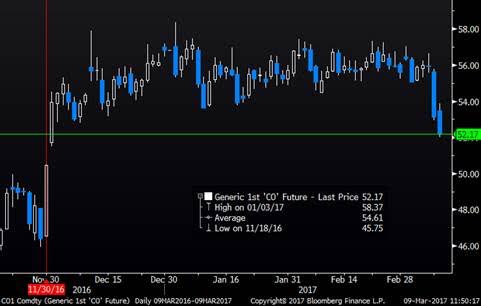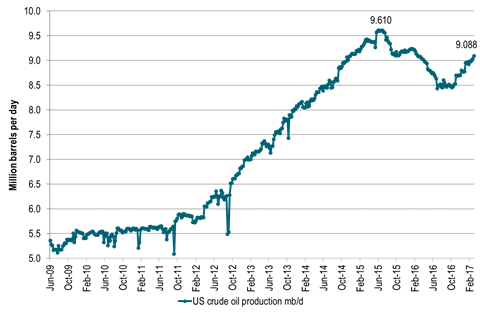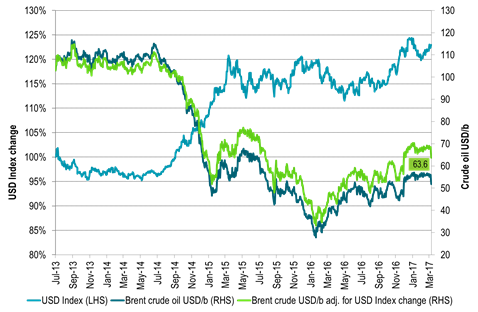Analys
US crude oil production, only a lower price can slow it down

 Price action – Long positions taking a hit – Pain trade to the down side
Price action – Long positions taking a hit – Pain trade to the down side
The front month Brent crude contract sold off 5% yesterday with a clos at $53.11/b. This was the lowest close for front month Brent since early December 2016 and clearly a break out of the close, sideways trend around $55/b which has been in place since OPEC decided to cut production in late November. Technically the Brent crude May 17 contract broke the important support level of $54.64/b. The next support level for the contract is $52.86/b and that has already been broken in today’s trading with Brent crude now trading at $52.3/b. Net long speculative positions are close to record high so if the bearish sentiment continues then oil prices are naturally and clearly vulnerable to the downside. That is where the pain-trade is.
It is worth mentioning that in a week on week perspective there has been a broad based sell-off in commodities in general with all sub-indices selling off between 2.6% and 4.4% and the total commodity index down 3.5%. In a week on week perspective Brent sold off 5.8% so a little more than the total energy index which sold off 3.9%. Still, oil was not alone in the sell-off. I.e. It was not just oil specific reasons for why oil sold off over the last week even though the sell-off came yesterday. In the background for all assets is the market concern for higher US interest rates which is hurting bonds, equities as well as commodities. Gold which is definitely sensitive to higher interest rates sold off 3.3% over the past week. The bullish US employment statistics yesterday probably helped to underpin the expectation for higher US rates.
Longer dated crude oil contracts also sold off yesterday with the Brent crude December 2020 contract closing yesterday at $53.74/b which is a new fresh low since April 2016. As stated earlier we expect this contract to trade yet lower down towards the $50/b mark in a pure neccessity to lower the implied shale oil profitability offered US shale oil players on a forward crude oil price curve. More than anything it is the one to three year forward contracts which needs to move lower in order to stemm the current strong rise in shale oil rigs and shale oil investments. Since OPEC decided to cut production in late November 2017 US shale oil players have been offered a nice profitable lunch on in the forward market basis.
Crude oil comment – US crude oil production, only a lower price can slow it down
The consequence of the increase in US oil rigs since the mid-May last year has now become alarmingly visible in US crude oil production. US crude oil production is growing. And it is growing strongly. That was one of the key bearish statistics in the US EIA’s data release yesterday. US crude oil production rose by 56 kb/d w/w to 9.088 mb/d. Sounds like little in the big picture but multiply by 52 weeks (if it is a steady trend rather than weekly noise) and you get a marginal, annualized US crude oil production growth rate of 2.9 mb/d. Since the start of 2017 the average US crude oil production growth has been +35 kb/d w/w. That equates to a marginal, annualized growth rate of 1.8 mb/d. We are in general very bullish US shale oil production growth. However, we had not expecte to see this level of growth rate before in September 2017.
There is only one way to slow down the US crude oil production growth and that is a lower oil price. Thus beside an overall bearish sell-off in commodities in general, the oil price is pushing lower. A marginal, annualized US crude oil production growth rate of 1.8 mb/d which we now have seen since the start of the year is too much, too early. The shale oil veteran Harrold Hamm this week said at the Cera Week in Houston that the current investment binge in US shale oil production will kill the oil market unless it is tempered. Pioneer’s Scott Sheffield was out earlier in the week stating that US Permian crude oil production could rise to 8-10 mb/d in 10 years time and thus surpas Saudi Arabia’s Ghawar field (biggest in the world today). He also said that the WTI crude oil price would fall to $40/b if OPEC doesn’t carry over its production cuts into H2-17. On top of this the US EIA revised its US crude oil production projections significantly higher yet again. We still think they are way behind the curve when they predict US crude oil production at 9.73 mb/d on average in 2018 versus our projection of 10.76 mb/d for that year. We thus think that the US EIA will revise higher its projections for US crude oil 2018 production projection again and again in 2017.
If US crude oil production continues to grow at the pace we have seen since the start of the year, then it will pass its past peak of 9.61 mb/d (which was reached in June 2015) by mid-June 2017. That is not our projection, just a pure mathematical extrapolation.
Shale oil service costs, labour costs and material costs are tellingly definitely on the rise. This could definitely slow down weekly rig count additions if the cost side starts to bit significantly. In that case the oil price would not need to move all that much lower in order to slow down rig count additions. However, we have not seen that effect yet. Normally there is a time lag of 6-8 weeks from the oil price moves to when we see a reduction or increase in the weekly US shale oil rig count numbers. As such even if the oil price now continues yet lower we are likely to see that the US shale oil rig count increases by 9-10 rigs every week the next 6-8 weeks.
We still think that oil inventories will fall in Q2-17 and as such give support to prices. Our expectations is to see the highest Brent crude oil price to be printed in Q2-17. However, US crude oil prodution is now growing so strongly that market focus is shifting away from OPEC cuts and over to US production growth. We had not expected this to happen before in late Q2-17.
Then we are left with the question – What will OPEC do in the face of strongly rising US crude oil production? The can decide to cut also in H2-17, but does it make sense? We think not. US shale oil production response is too fast and too flexible.
Ch1: Brent crude front month contract – Breaking the sideways trend. Back to pre-OPEC-cut-decission?
Ch2: US crude oil production rising strongly – too strongly. Now just 0.5 mb/d below prior peak
If it continues at this pace then US crude production will pass the 9.6 mb/d mark in June 2017
Ch3: Brent crude oil 1mth contract adjusted for US dollar strength since July 2013.
For all those longing for a Brent crude oil price of $60/b it is worth remembering that
if we adjust for the 23% stronger USD since July 2013 a Brent price today of only $51/b actually equals $63.6/b in 2013 USD terms.
In that perspective we are already “back above $60/b”. Acutally we were close to $70/b in 2013 dollar terms when Brent averaged $55/b so far this year.
Kind regards
Bjarne Schieldrop
Chief analyst, Commodities
SEB Markets
Merchant Banking
Analys
Fear that retaliations will escalate but hopes that they are fading in magnitude

Brent crude spikes to USD 90.75/b before falling back as Iran plays it down. Brent crude fell sharply on Wednesday following fairly bearish US oil inventory data and yesterday it fell all the way to USD 86.09/b before a close of USD 87.11/b. Quite close to where Brent traded before the 1 April attack. This morning Brent spiked back up to USD 90.75/b (+4%) on news of Israeli retaliatory attack on Iran. Since then it has quickly fallen back to USD 88.2/b, up only 1.3% vs. ydy close.

The fear is that we are on an escalating tit-for-tat retaliatory path. Following explosions in Iran this morning the immediate fear was that we now are on a tit-for-tat escalating retaliatory path which in the could end up in an uncontrollable war where the US unwillingly is pulled into an armed conflict with Iran. Iran has however largely diffused this fear as it has played down the whole thing thus signalling that the risk for yet another leg higher in retaliatory strikes from Iran towards Israel appears low.
The hope is that the retaliatory strikes will be fading in magnitude and then fizzle out. What we can hope for is that the current tit-for-tat retaliatory strikes are fading in magnitude rather than rising in magnitude. Yes, Iran may retaliate to what Israel did this morning, but the hope if it does is that it is of fading magnitude rather than escalating magnitude.
Israel is playing with ”US house money”. What is very clear is that neither the US nor Iran want to end up in an armed conflict with each other. The US concern is that it involuntary is dragged backwards into such a conflict if Israel cannot control itself. As one US official put it: ”Israel is playing with (US) house money”. One can only imagine how US diplomatic phone lines currently are running red-hot with frenetic diplomatic efforts to try to defuse the situation.
It will likely go well as neither the US nor Iran wants to end up in a military conflict with each other. The underlying position is that both the US and Iran seems to detest the though of getting involved in a direct military conflict with each other and that the US is doing its utmost to hold back Israel. This is probably going a long way to convince the market that this situation is not going to fully blow up.
The oil market is nonetheless concerned as there is too much oil supply at stake. The oil market is however still naturally concerned and uncomfortable about the whole situation as there is so much oil supply at stake if the situation actually did blow up. Reports of traders buying far out of the money call options is a witness of that.
Analys
Fundamentals trump geopolitical tensions

Throughout this week, the Brent Crude price has experienced a decline of USD 3 per barrel, despite ongoing turmoil in the Middle East. Price fluctuations have ranged from highs of USD 91 per barrel at the beginning of the week to lows of USD 87 per barrel as of yesterday evening.

Following the release of yesterday’s US inventory report, Brent Crude once again demonstrated resilience against broader macroeconomic concerns, instead focusing on underlying market fundamentals.
Nevertheless, the recent drop in prices may come as somewhat surprising given the array of conflicting signals observed. Despite an increase in US inventories—a typically bearish indicator—we’ve also witnessed escalating tensions in the Middle East, coupled with the reinstatement of US sanctions on Venezuela. Furthermore, there are indications of impending sanctions on Iran in response to the recent attack on Israel.
Treasury Secretary Janet Yellen has indicated that new sanctions targeting Iran, particularly aimed at restricting its oil exports, could be announced as early as this week. As previously highlighted, we maintain the view that Iran’s oil exports remain vulnerable even without further escalation of the conflict. It appears that Israel is exerting pressure on its ally, the US, to impose stricter sanctions on Iran, an action that is unfolding before our eyes.
Iran’s current oil production stands at close to 3.2 million barrels per day. Considering additional condensate production of about 0.8 million barrels per day and subtracting domestic demand of roughly 1.8 million barrels per day, the net export of Iranian crude and condensate is approximately 2.2 million barrels per day.
However, the uncertainty surrounding the enforcement of such sanctions casts doubt on the likelihood of a complete ending of Iranian exports. Approximately 80% of Iran’s exports are directed to independent refineries in China, suggesting that US sanctions may have limited efficacy unless China complies. The prospect of China resisting US pressure on its oil imports from Iran poses a significant challenge to US sanctions enforcement efforts.
Furthermore, any shortfall resulting from sanctions could potentially be offset by other OPEC nations with spare capacity. Saudi Arabia and the UAE, for instance, can collectively produce an additional almost 3 million barrels of oil per day, although this remains a contingency measure.
In addition to developments related to Iran, the Biden administration has re-imposed restrictions on Venezuelan oil, marking the end of a six-month reprieve. This move is expected to impact flows from the South American nation.
Meanwhile, US crude inventories (excluding SPR holdings) surged by 2.7 million barrels last week (page 11 attached), reaching their highest level since June of last year. This increase coincided with a decline in measures of fuel demand (page 14 attached), underscoring a slightly weaker US market.
In summary, while geopolitical tensions persist and new rounds of sanctions are imposed, our market outlook remains intact. We maintain our forecast of an average Brent Crude price of USD 85 per barrel for the year 2024. In the short term, however, prices are expected to hover around the USD 90 per barrel mark as they navigate through geopolitical uncertainties and fundamental factors.
Analys
Brace for Covert Conflict

In the past two trading days, Brent Crude prices have fluctuated between highs of USD 92.2 per barrel and lows of USD 88.7 per barrel. Despite escalation tensions in the Middle East, oil prices have remained relatively stable over the past 24 hours. The recent barrage of rockets and drones in the region hasn’t significantly affected market sentiment regarding potential disruptions to oil supply. The key concern now is how Israel will respond: will it choose a strong retaliation to assert deterrence, risking wider regional instability, or will it revert to targeted strikes on Iran’s proxies in Lebanon, Syria, Yemen, and Iraq? While it’s too early to predict, one thing is clear: brace for increased volatility, uncertainty, and speculation.

Amidst these developments, the market continues to focus on current fundamentals rather than unfolding geopolitical risks. Despite Iran’s recent attack on Israel, oil prices have slid, reflecting a sideways or slightly bearish sentiment. This morning, oil prices stand at USD 90 per barrel, down 2.5% from Friday’s highs.
The attack
Iran’s launch of over 300 rockets and drones toward Israel marks the first direct assault from Iranian territory since 1991. However, the attack, announced well in advance, resulted in minimal damage as Israeli and allied forces intercepted nearly all projectiles. Hence, the damage inflicted was limited. The incident has prompted US President Joe Biden to urge Israel to exercise restraint, as part of broader efforts to de-escalate tensions in the Middle East.
Israel’s response remains uncertain as its war cabinet deliberates on potential courses of action. While the necessity of a response is acknowledged, the timing and magnitude remain undecided.
The attack was allegedly in retaliation for an Israeli airstrike on Iran’s consulate in Damascus, resulting in significant casualties, including a senior leader in the Islamic Revolutionary Guard Corps’ elite Quds Force. It’s notable that this marks the first direct targeting of Israel from Iranian territory, setting the stage for heightened tensions between the two nations.
Despite the scale of the attack, the vast majority of Iranian projectiles were intercepted before reaching Israeli territory. However, a small number did land, causing minor damage to a military base in the southern region.
President Biden swiftly condemned Iran’s actions and pledged to coordinate a diplomatic response with leaders from the G7 nations. The US military’s rapid repositioning of assets in the region underscores the seriousness of the situation.
Iran’s willingness to escalate tensions further depends on Israel’s response, as indicated by General Mohammad Bagheri, chief of staff of the Iranian armed forces. Meanwhile, speculation about a retaliatory attack from Israel persists.
Looking ahead, key questions remain unanswered. Will Iran launch additional attacks? How will Israel respond, and what implications will it have for the region? Moreover, how will Iran’s allies react to the escalating tensions?
Given the potential for a full-scale war between Iran and Israel, concerns about its impact on global energy markets are growing. Both the United States and China have strong incentives to reduce tensions in the region, given the destabilizing effects of a regional conflict.
Our view in conclusion
The recent escalation between Iran and Israel underscores the delicate balance of power in the volatile Middle East. With tensions reaching unprecedented levels and the specter of further escalation looming, the potential for a full-blown conflict cannot be understated. The ramifications of such a scenario would be far-reaching and could have significant implications for regional stability and global security.
Turning to the oil market, there has been much speculation about the possibility of a full-scale blockade of the Strait of Hormuz in the event of further escalation. However, at present, such a scenario remains highly speculative. Nonetheless, it is crucial to note that Iran’s oil production and exports remain at risk even without further escalation. Currently producing close to 3.2 million barrels per day, Iran has significantly increased its production from mid-2020 levels of 1.9 million barrels per day.
In response to the recent attack, Israel may exert pressure on its ally, the US, to impose stricter sanctions on Iran. The enforcement of such sanctions, particularly on Iranian oil exports, could result in a loss of anywhere between 0.5 million to 1 million barrels per day of oil supply. This would likely keep the oil market in deficit for the remainder of the year, contradicting the Biden administration’s wish to maintain oil and gasoline prices at sustainable levels ahead of the election. While other OPEC nations have spare capacity, utilizing it would tighten the global oil market even further. Saudi Arabia and the UAE, for example, could collectively produce an additional almost 3 million barrels of oil per day if necessary.
Furthermore, both Iran and the US have expressed a desire to prevent further escalation. However, much depends on Israel’s response to the recent barrage of rockets. While Israel has historically refrained from responding violently to attacks (1991), the situation remains fluid. If Israel chooses not to respond forcefully, the US may be compelled to promise stronger enforcement of sanctions on Iranian oil exports. Consequently, Iranian oil exports are at risk, regardless of whether a wider confrontation ensues in the Middle East.
Analyzing the potential impact, approximately 2.2 million barrels per day of net Iranian crude and condensate exports could be at risk, factoring in Iranian domestic demand and condensate production. The effectiveness of US sanctions enforcement, however, remains uncertain, especially considering China’s stance on Iranian oil imports.
Despite these uncertainties, the market outlook remains cautiously optimistic for now, with Brent Crude expected to hover around the USD 90 per barrel mark in the near term. Navigating through geopolitical tensions and fundamental factors, the oil market continues to adapt to evolving conflicts in the Middle East and beyond.
-

 Nyheter2 veckor sedan
Nyheter2 veckor sedanGuldpriset når nytt all time high och bryter igenom 2300 USD
-

 Nyheter4 veckor sedan
Nyheter4 veckor sedanGuld toppar 2200 USD per uns
-

 Nyheter3 veckor sedan
Nyheter3 veckor sedanLundin Mining får köprekommendation av BMO
-

 Nyheter4 veckor sedan
Nyheter4 veckor sedanVertikal prisuppgång på kakao – priset toppar nu 9000 USD
-

 Nyheter4 veckor sedan
Nyheter4 veckor sedanKaffepriserna stiger på lågt utbud och stark efterfrågan
-

 Nyheter2 veckor sedan
Nyheter2 veckor sedanCentralbanker fortsatte att köpa guld under februari
-

 Nyheter2 veckor sedan
Nyheter2 veckor sedanHur mår den svenska skogsbraschen? Två favoritaktier
-

 Nyheter2 veckor sedan
Nyheter2 veckor sedanKakaomarknaden är extrem för tillfället










